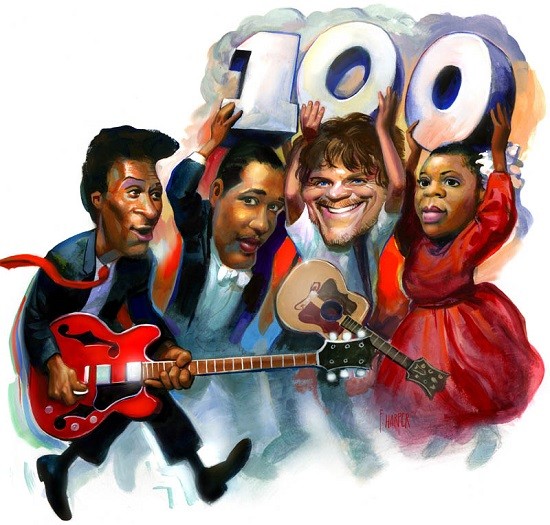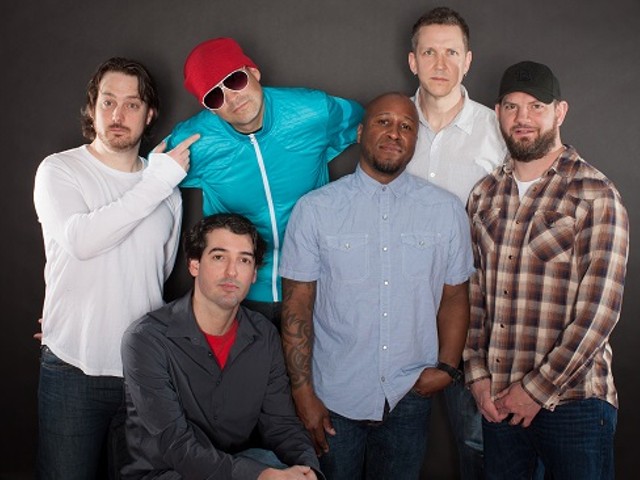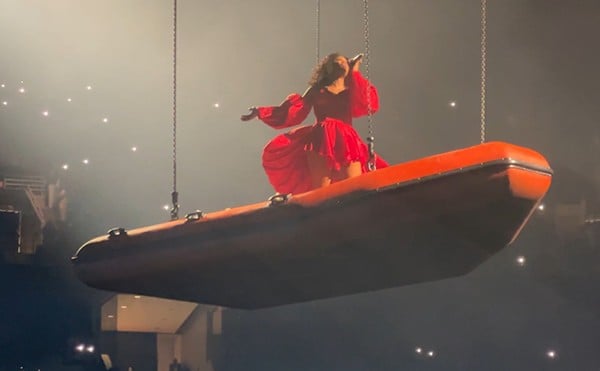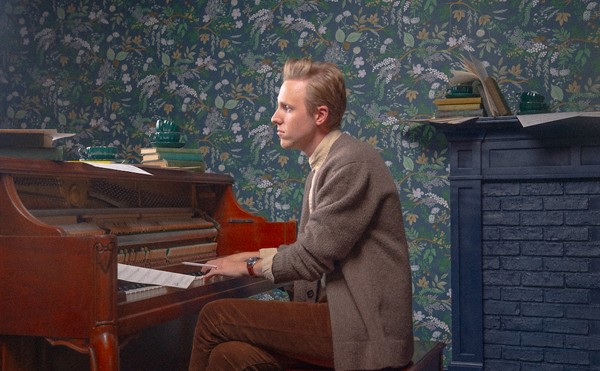
By Roy Kasten, Christian Schaeffer and RFT Music
St. Louis isn't just a city. It's a song. Or rather songs, hundreds, thousands and more. Don't bother counting. We tried.
In back rooms and basements, on stages and streets, musicians have paid tribute to St. Louis again and again. Place matters. St. Louis doesn't define artists like Chuck Berry or Scott Joplin or Nelly. On the contrary, those performers helped define the city by producing music that reflects its depth and variety. Their songs, and those of countless other musicians, tell the city's story and represent it to the world.
This is a list of 100 of the greatest songs about, for and of St. Louis. It's not a roundup of our greatest musicians (though many are here), nor is it a catalog of influential tunes (though they're here, too), or a compendium of songs that namedrop St. Louis. Rather, this is a list about what it means to invoke St. Louis in song.
Many of the artists on this list (and we limited ourselves to one song per artist) are St. Louisans. Some never lived here but were inspired by this town. Just ask 1920s chanteuse Bessie Smith ("St. Louis Blues") or R&B crooner Lloyd Price ("Stagger Lee"): Summon St. Louis, and you scratch a touchstone. The city is home to the father of rock & roll; it's also a homeland for anyone who loves music.
Some songs use St. Louis to evoke a feeling -- be it the gritty blues of the city's 20th-century industrialism or the earthy twang of its frontier heritage. Others look unflinchingly at the region's fault lines of race, class and opportunity. One proclaims pride for the Lou; the next wonders what the hell happened. Every song, however, is rooted in a love for St. Louis.
Can a city enriched by the confluence of major rivers and complex cultures be reduced to a playlist? Not likely. These 100 songs, spanning three centuries, are not a reduction. In words and music, they expand the story of a St. Louis both real and imagined. Nearly every style of American music has emerged from or passed through this place and come out changed. When musicians pay tribute to St. Louis, they are joining our deep musical streams.
We'd like to acknowledge some very kind music lovers who made valuable suggestions for this list: Ed Becker, Michael Bishop, Art Dwyer, Ron Edwards, Bil Gelb, Matt Harnish, Chris King, Mark Mason, Dean Minderman, Jim Nelson, Jack Petracek, Tom Ray, René Spencer Saller, Dennis Stegmann, Josh Weinstein and Toby Weiss. Thanks also to Nick Lucchesi and Kiernan Maletsky, who first suggested this project years ago. Extra special thanks to Dennis Owsley, whose book City of Gabriels: The History of Jazz in St. Louis, 1895-1973 was beyond helpful, and Kevin Belford, who offered generous advice and insight. Belford's book (and blog) Devil at the Confluence is an inspiration.
100. Emmett Miller - "The Ghost of the St. Louis Blues" (1929)
This countdown of 100 songs begins where it ends (or vice versa, if you prefer), with "The St. Louis Blues," or rather with the ghost of that song -- and the specter of the trickster to end all musical tricksters, Emmett Miller. So much more than just a minstrel performer, Miller is like the missing link between blues, jazz, country and even rock & roll. On this parody, he and his band the Georgia Crackers have a comedic ball with W. C. Handy's immortal song, turning it into a politically incorrect séance, with his piercing yodel all but mocking the sound of Louis Armstrong's coronet, as recorded four years earlier. Miller (and composers Billy Curtis and J. Russell Robinson) had one thing right: You can't escape an earworm like "The St. Louis Blues." But you'd have to be as insane as Miller sounds to even try. -Roy Kasten
99. Bottoms Up Blues Gang - "South Broadway Blues" (2002)
A good blues song needn't have flashy solos or hellhounds on its trail; sometimes it can be simple celebration of where you come from and where you'll always return. The acoustic-blues minimalists (at least when performing as a trio or even as the core duo of Kari Liston and Jeremy Segel-Moss) of Bottoms Up Blues Gang know that all roads lead back to the Arch and the stomping grounds of Benton Park and Soulard, where the legends before them -- Tommy Bankhead and Oliver Sain, to mention just two named in this song -- set the tone for sharing life-affirming music in small clubs you wouldn't want to live without. -RK
98. Oliver Cobb & His Rhythm Kings - "The Duck's Yas Yas Yas" (1929)
The original version of this party tune was recorded by piano player James "Stump" Johnson in early 1929, though fellow St. Louisan Oliver Cobb gave it a hot big-band arrangement that surely widened its appeal into the '30s, and remains the one you gotta hear (though don't miss Johnson's original, with expanded lyrics and bonus local color). When he scats, Cobb isn't shy about letting his Satchmo influences show, and he's also not shy about giving every musician (down to the banjo and doghouse bass) a few seconds in the spotlight as they all march down to Market Street "where the women all meet." "Yas yas," of course, is slang for hind parts, and we're not talking about a duck's tail feathers. -RK
97. Bessie Mae Smith and Wesley Wallace - "St. Louis Daddy" (1929)
We know all about the St. Louis women, with their diamond rings, apron strings, makeup and "store-bought hair." In 1929, Bessie Mae Smith (who recorded under various names, including Mae Belle Miller) sounds like she has just about had enough. She pleads with accompanist Wesley Wallace to cut the crap, and over some easy-striding piano he keeps dishing it out. Smith's voice has a creaky, sexy, smoky quality to it that must have driven Wallace (not to mention husband Big Joe Williams) crazy; it would have done the same for pre-Depression barrelhouses all over town. -RK
96. Erin Bode - "St. Louis Song" (2006)
As a singer comfortable moving between the jazz and folk worlds, Erin Bode has often been hailed as St. Louis' answer to Norah Jones. Her talent has taken her far and wide, but on "St. Louis Song" she plants her feet in her hometown. The track, from Bode's 2006 release Over and Over from the Webster Groves-based MAXJAZZ label, could be set in any city where two lovers part ways, but something about Bode's lyrics fits our city like a glove. Her man wants to leave St. Louis, but she wants to stay, though she sounds confident that he'll return home someday. Any outsider who has ever fallen in love with a Mound City native probably knows the feeling, and as Bode glides through the delicate guitar figure and sonorous bass runs, she tells of a love for her city that, at least this time, trumps romance. -Christian Schaeffer
95. Johnny Paycheck - "The Spirits of St. Louis" (1977)
Leave it to Johnny Paycheck to record one of the all-time great drinking songs (written by Roger Bowling and R.J. Jones) for a town that loves a good drinking song. Paycheck sings the hell out of the chorus -- "I've sipped Tennessee's best whiskey / Drank every bar dry in this old city / But all the spirits in St. Louis can't get you off my mind" -- and the band (flush with dobro, harmonica and a rhythm section that ticks steady as a clock hand headed to closing time) matches him phrase for set-'em-up-knock-'em-down phrase. If this song isn't on the jukebox, you're in the wrong honky-tonk. -RK
94. Dave Van Ronk - "Duncan and Brady" (1959)
When it comes to the rabbit holes of American murder ballads, few are as deep and labyrinthine as "Duncan and Brady." Based on a murder in St. Louis (Eleventh Street and Lucas Avenue, to be exact) on October 6, 1890, the song has traveled under various names (the first recording, by the string band Wilmer Watts & the Lonely Eagles, bore the title "Been on the Job Too Long") and accrued details that don't match up to history. Go figure. What we do know is James Brady was the police officer slain at the rowdy tavern, and Harry Duncan, a black man and local singer, was the accused. Despite numerous appeals, Duncan would hang for the crime, though the saloon's owner, Charles Starkes, ultimately copped to the murder in a deathbed confession. Just about everybody who's anybody in folk music (Lead Belly, Judy Henske, Bob Dylan) has recorded this bad-man ballad. Dave Van Ronk's interpretation from 1959 deserves special notice for its crisp, growling soul. -RK
93. Signifying Mary Johnson - "Delmar Avenue" (1936)
The disparity between rich and poor, and often between black and white, in the city of St. Louis has often been typified by what is called "the Delmar Divide": great wealth, infrastructure and opportunity on the south side of Delmar Boulevard, great poverty on the north. Listen to enough blues music, and you'll find that the street was the setting for a different kind of pain. In this 1936 recording, slide guitarist James "Kokomo" Arnold and singer Mary Johnson tell of empty streets, rain clouds and "ragged daddies." It's desolate and dark, and while Johnson sings of wanting to cry, Arnold's bottleneck runs feel one step ahead of her. -CS
92. DJ Quik - "Jus Lyke Compton" (1992)
It's one thing to rap about street life but quite another to witness the consequences. On tour to promote his first album, rapper/producer DJ Quik was surprised to see LA-style gang culture spread across America. He recounted some of his experiences in "Jus Lyke Compton." In St. Louis, "where they country as fuck," Quik and his entourage rolled in on a typical hot summer day. They met some friendly locals who showed them some local spots, including the Smith Center and Gus's Fashions. After the show, however, there was a shootout between local gangs who had adopted the Blood and Crip symbols they'd seen in movies and heard in records. Quik was left shaking his head: "In Missouri?" he raps. "Damn, how could this happen?" -Mike Appelstein
91. Henry Brown - "Deep Morgan Blues" (1929)
The area known as Deep Morgan appears elsewhere on this list of songs, either in spirit or in location. Located on Biddle Street in what was known as north St. Louis' "Bloody 3rd Ward" at the turn of the century, Deep Morgan was where "Stack" Lee Shelton shot William Lyons, but it was also a red-light district that was home to the city's music clubs. As such, the neighborhood offered fertile ground for the evolution of ragtime, blues and jazz, and it's that history that piano player Henry Brown channels in "Deep Morgan Blues." The Tennessee-born Brown moved to St. Louis at age twelve and came to be known as a barrelhouse piano player with few peers; you can hear him exemplify the form on this track, with its stately walking bass line keeping time for Brown's more emphatic right hand. Listen closely and you can hear elements of Deep Morgan's musical contributions to American music in this three-minute rag. -CS





